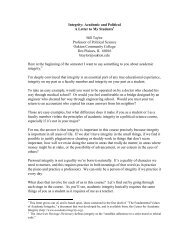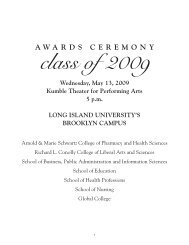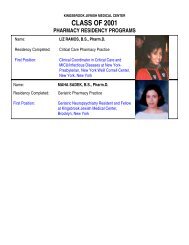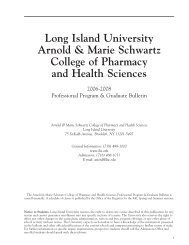united nations advanced certificate faculty - Long Island University
united nations advanced certificate faculty - Long Island University
united nations advanced certificate faculty - Long Island University
You also want an ePaper? Increase the reach of your titles
YUMPU automatically turns print PDFs into web optimized ePapers that Google loves.
The Second World War was underway while you were pursuing your bachelor’s in Japan.<br />
Did the political / social changes of those days influence somehow the branch of learning you<br />
chose to study?<br />
Not a bit. I had decided to enter the medical science area. Fortunately, military service was<br />
exempted for those joining this <strong>faculty</strong>. Therefore, I was not involved at all in anything connected<br />
with the war.<br />
You have had an extensive career at the UN, starting as a Social Affairs Officer in the<br />
Population Branch of the Bureau of Social Affairs in 1957. How did it all begin?<br />
Japan was admitted to the UN in 1956. The UN Secretariat, in 1957, was looking forward to<br />
recruiting Japanese nationals, and the population branch within the Bureau of Social Affairs was<br />
very much interested in recruiting young demographers. Around that time, the International Union<br />
for the Scientific Study of Population, which was the only international academic organization,<br />
recommended me. I was also supported by my university and by the Dean of the School of<br />
Hygiene of Johns Hopkins <strong>University</strong>. As a consequence, I was one of the first seven Japanese<br />
recruited by the UN secretariat.<br />
You mentioned that the Secretariat was very much interested in having Japanese nationals<br />
particularly in the area of population. Why was that?<br />
During and immediately after World War II, Japanese life expectancy was very low because of<br />
war casualties, including those caused by the atomic bomb. The life expectancy of Japanese males<br />
went down to 20 years of age, which was equivalent to that of the ancient Greeks! However, life<br />
expectancy went up quite quickly, as did the birth rate, thereby causing an explosive population<br />
growth. In an attempt to moderate the population growth rate, the government reacted by liberalizing<br />
abortions, which proved quite effective. For that matter, although family planning and abortion<br />
were almost a taboo in the UN at that time, many improvements were made through the study<br />
of demographic issues. I was particularly involved in life table constructions for Japan and with<br />
the various technological aspects of concern to the UN population branch. All this was very much<br />
in tune with my own research work.<br />
From 1959 to 1960 there seems to be a break in your UN career, as you were appointed as a<br />
Technical Adviser to the Council of Ministers of the government of Sudan. How did you like<br />
this experience? Were you taken on to deal with a specific issue?<br />
I was the technical adviser to the Council of Ministers of the Revolutionary Government of Sudan<br />
(1959-60). One of my major assignments was to make an analysis of the first Sudanese population<br />
census, which was taken by the government following independence. They wanted to incorporate<br />
future population and labor projections into national development planning. I was assigned<br />
to analyze this first census and make population projections based on my results. It was very challenging<br />
technical work, and somehow we succeeded in making accurate projections for the next<br />
15 years. The same procedure is still in use.<br />
6













